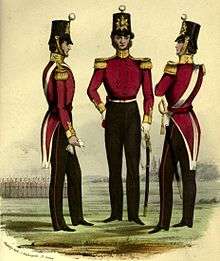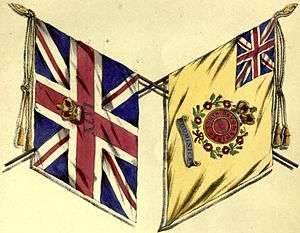46th (South Devonshire) Regiment of Foot
| 46th (South Devonshire) Regiment of Foot | |
|---|---|
|
Colours of the 46th Regiment | |
| Active | 1741–1881 |
| Country | United Kingdom |
| Branch | Army |
| Type | Line Infantry |
| Role | Light Infantry |
| Size | One battalion |
| Nickname(s) | Red Feathers, Murray's Bucks, The Surprisers , Lacodemonian's. |
| Colors | Light Yellow Facing, Silver Braided Lace |
| March | Quick: Slow: |
| Engagements | Battle of Prestonpans, (1745), The Conquest of Canada (1756-1762), American Revolutionary War (1775-1783), Dominica (1808), Battle of the Alma (1854), Sevastopol (1855), Redan (1855) |
The 46th (South Devonshire) Regiment of Foot was an infantry regiment of the British Army, created in 1741 and amalgamated into the Duke of Cornwall's Light Infantry in 1881.
History

The regiment was raised at Newcastle in 1741 as the 57th Regiment of Foot, ranked as the 46th Regiment of Foot in 1751, and took a county title as the 46th (South Devonshire) Regiment of Foot in 1782.
A red 'ball tuft' distinction was worn on the Shako (cap) by the Light company of the 46th from 1833, later by the whole regiment, until 1878. From this the 46th took their nickname 'The Red Feathers', which upheld a tradition allegedly dating from the Light company's role at Paoli's Tavern during the American War of Independence.
In 1749 the Regiment was stationed in Ireland, where they remained for eight years. Whilst they were in Ireland, the Seven Years' War broke out, and the 46th were relocated to Nova Scotia. During their time in Canada, the 46th were involved in several battles, including:
- Assault on Fort Ticonderoga, July 8, 1758;
- Assault and Capture of Fort Niagara, July 25, 1759;
- Assault and Capture of Fort Lévis, August 25, 1760;
- Capture of Montreal,September 8, 1760;
In 1762 they fought in the Caribbean, taking part in the following actions:
- The Capture of Martinique, 1762;
- Assault and Capture of the Heights of Morne Tartenson, January 24, 1762;
- Assault and Capture of the Heights of Morne Garnier, January 27, 1762;
- Capture of Fort Royal, February 4, 1762;
- Capture of Havanna, Cuba, 1762;
- Storm of the Moro Fort, July 30, 1762;
- Siege and Fall of Havanna, August 13, 1762.
In the American War of Independence the 46th Regiment of Foot fought at Capture of Long Island, August 28, 1776; Capture of New York, 1776; Capture and Reduction of Fort Washington, 1776; Battle of Brandywine Creek, September 11, 1777; Action of Paoli's Tavern, September 20, 1777; Capture of Philadelphia, 1777; Battle of Germantown, October 4, 1777; Action of Monmouth Court-House, June 28, 1778; Assault and Capture of Bedford, September 5, 1778 Assault and Capture of Martha's Vineyard, September, 1778; Invasion and Capture of St. Lucia, December 30, 1778; Defence of La Vigie, December 18, 1778; and the Capture of St. Eustatius, 1781.
On 22 February 1805 a French fleet arrived off the island of Dominica, where the 46th were on garrison duty with the 1st West India Regiment. Driven back by French troops to Fort Prince Rubert the 46th refused to surrender and held out for a week until the French withdrew and sailed away. The regiment was awarded "Dominica" as its first battle honour.[1]
On 24 May 1806, men from the regiment stationed at Dominica augmented the packet boat Duke of Montrose and set out in pursuit of the French privateers Napoleon and Imperial and their prize, a schooner they had cut out from Roseau. They captured Imperial while another small detachment, in boats, captured the prize. HMS Wasp captured Napoleon.
The 46th Regiment arrived in the British colony of New South Wales to replace the 73rd Regiment of Foot (1st Battalion Highlanders) in February 1814, and were relieved by the 48th (Northamptonshire) Regiment of Foot in 1817. Whilst in New South Wales, the Regiment saw service in Sydney, Newcastle, Parramatta and Van Diemens Land before leaving for Madras in 1817. During their service in New South Wales, the 46th were commanded by Lieut. Colonel G. Molle. In 1820 apparently a detachment traveled on HMS Coromandel as escorts for convicts bound for Van Diemen's Land and New South Wales.
During the Crimean War, (1854-1856) the 46th were involved at the Battle of the Alma, September 20, 1854; the Battle of Balaklava, October 25, 1854; the Battle of Inkermann, November 5, 1854; the Siege of Sebastopol, September 25, 1854 to September 8, 1855; the Trench Warfare; the Assault on the Quarries, June 7, 1855; the First Assault on the Redan, June 18, 1855 and the Final Assault on the Redan, September 18, 1855.
The 46th (South Devonshires) Regiment of Foot united with 32nd (Cornwall) Regiment of Foot to form The Duke of Cornwall's Light Infantry on January 7, 1881.
Battle Honours
Battle honours were:[2]
- Dominica (1805)
- Crimean War: Sevastopol
Colonels
Colonels of the regiment were:[3]
- 1741.01.13 Brig-Gen. John Price
- 1743.06.23 Lt-Gen. Hon. Thomas Murray
The 46th Regiment of Foot - (1748)
- 1764.11.21 Gen. Sir William (Howe), 5th Viscount Howe, KB
- 1775.05.11 Lt-Gen. Hon. Sir John Vaughan, KB
The 46th (South Devon) Regiment - (1782)
- 1795.08.01 Gen. Sir James Henry Craig, KB
- 1804.01.05 Gen. John Whyte
- 1816.04.01 Gen. Henry Wynyard
- 1838.04.06 Lt-Gen. Sir John Keane, 1st Baron Keane, GCB, GCH
- 1839.08.01 Lt-Gen. John Ross, CB
- 1843.05.31 Gen. Sir John Hamilton Dalrymple, Bt., later 8th Earl of Stair, KT
- 1853.01.24 Lt-Gen. Richard Egerton, CB
- 1854.11.19 Gen. Sir John Lysaght Pennefather, GCB
- 1860.02.13 Lt-Gen. John Geddes, KH
- 1860.04.24 Gen. Thomas Gerrard Ball
- 1861.06.17 Lt-Gen. Sir Charles Ash Windham, KCB
- 1870.02.03 Lt-Gen. Edward Hungerford Delaval Elers Napier
- 1870.06.20 Gen. Charles Stuart
References
- ↑ Burnham, Bob. The British Army Against Napoleon: Facts, Lists and Trivia, 1805-1815. p. 238.
- ↑ Chant, Christopher. The Handbook of British Regiments (Routledge Revivals). p. 144.
- ↑ "46th (South Devonshire) Regiment of Foot". regiments.com. Archived from the original on 22 October 2007. Retrieved 14 July 2016.
- Cannon, Richard (1851). Historical Record of the Forty-Sixth, or the South Devonshire Regiment of Foot. London: J. W. Parker.
